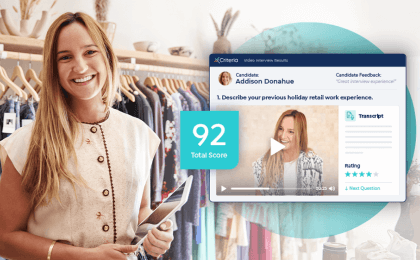Bias is an intrinsic part of the human condition – everyone holds some level of preference and makes assumptions about others. And even when you acknowledge and confront your own conscious and unconscious biases, it’s hard to be perfectly objective.
But objectivity is vital to a fair, effective, and ultimately successful hiring process. Hiring bias can gets in the way of making a great hire. And in a hiring landscape full of candidates with diverse backgrounds and experiences, it’s critical to confront hiring bias head on. But what exactly is hiring bias, and what is the best way to reduce it in your recruitment process?
What is Bias in Hiring?
Hiring bias occurs when part of the applicant review process gets influenced by candidate traits and information that aren’t relevant to the job. Often, we think of hiring bias only as something unfairly discriminates against candidates, removing them from consideration for the role. But bias can also result from a candidate gaining an unearned edge over their competition.
These biases typically stem from things candidates have little to no control over, from their physical characteristics to their demographics. There are many different types of bias that can influence a hiring decision, but the most challenging ones to tackle are the ones that we are the least aware of.
Unconscious bias definition
Unconscious bias, sometimes called implicit bias, is a type of mental shortcutting our brains learn to take to save us time and make faster decisions. Implicit bias is the human tendency to make judgements others without full context or necessary information.
Stereotypes, gut feelings, and vibe checks are all unfounded judgements we make because of unconscious biases. While this type of quick thinking was essential to the life-or-death decisions that our ancient ancestors made, speculation and intuition-driven decision-making have no place in the modern hiring process.
Implicit vs. explicit bias
Explicit bias is the blatant prejudice that we traditionally think of when we imagine bias. These are the judgements and preferences that people are aware that they hold, including things like overt racism, homophobia, ageism, classism, and sexism. Explicit bias can be quickly identified and recognized because it is expressed directly and deliberately. In contrast, implicit bias seeps into our subconscious thoughts and feelings in ways that are harder to pinpoint, but still influences our actions and the choices we make.
For example, an explicit bias would be a manager outright saying that they don’t believe a female employee who has children is serious about her career. An implicit bias would be if a manager chose not to promote female workers who are mothers according to a baseless instinct that makes them feel like women wouldn’t be able handle more work due to familial obligations. Implicit bias is more difficult to catch, but it is no less insidious in when it comes to hiring decisions.
Why It’s Important to Reduce Hiring Bias
Reducing hiring bias is the best way to ensure that your recruitment process provides equal opportunity for success. Decreasing bias allows you to more accurately predict which potential new hires are likely to succeed with your organization in the long term. Doing so has a direct impact on your bottom line.
Equality improves quality of hire.
By making your hiring process more fair and equitable, you are better able to cut through the noise and determine which of your candidates are best equipped to take on the role. Objective and evidence-based hiring refocuses evaluators on the things that truly matter on the job. When you can effectively mitigate bias, you’re able to do a better job of discovering a candidate’s job-relevant skills, abilities, and potential.
More diverse workplaces perform better.
Studies have shown that when employers make a conscious effort to reduce the unconscious bias in the hiring process, they are more likely to have a diverse workforce. This resulting diversity – of background, thought, and experience – creates teams that drive more innovation, make better decisions, and can adapt faster than more homogenous groups.
How to Avoid Bias in Interviews
Now that we understand why it’s important to mitigate hiring bias, we have to consider how that can actually be accomplished. And while there’s no magic wand that can be waved to completely irradicate unconscious bias in hiring, there are many practical ways to reduce it.
Objective Assessments Reduce Implicit Bias in Interviews
Scientifically validated assessments are a great tool for effectively evaluating candidate skills, abilities, and competencies without the risk of human interference in the process. Criteria’s pre-employment assessments, from personality to cognitive ability to skills tests, are designed to objectively identify which candidates have the strongest likelihood of succeeding on the job. Pre-hire assessments help reduce bias, make it easier for hiring managers to directly compare candidates on their job-related abilities, and demonstrate the ability to predict future success better than resumes, conversational interviews, and education.
Blind Hiring Helps to Limit Interviewer Bias
Blind hiring is the practice of removing non-relevant candidate information to limit its influence it could have on a hiring decision. This means anonymizing certain aspects of a candidate, like removing their name (which can be indicative of gender, sex, race, or age), the school they went to, or their address from their resume before it is shared with hiring managers. Blind hiring forces evaluators to look at the factors that actually influence a candidate’s performance in the role by removing non-predictive distractions.
Structured Interviewing Reduces Bias Throughout the Hiring Process
Adding structured interviews as a part of candidate review is a great way to reduce the overall bias in your hiring process. By design, structured interviews adhere to a consistent process, asking each candidate the same job-relevant questions and scoring their responses with a common rubric.
Ways to Reduce Bias with Structured Video Interviews
By incorporating structured video interviewing into your hiring process, you significantly mitigate the risk of biased candidate review. One of the benefits of video interviewing is how seamlessly it can be added early in the hiring process. This ensures that the candidates you’re moving forward in your hiring funnel are more likely to be objectively validated, increasing the likelihood of fair and effective evaluation.
Structured video interviewing combines the convenience of virtual interviewing with the predictive rigor of a structured interview. The result is an improved hiring process that champions diversity and helps you find top talent. Let’s look a little deeper at how structured virtual interviews accomplish that.
Digital interviewing enable real-time blind hiring.
Using video interviewing gives you access to tools that would make blind-hiring otherwise impossible in an interview setting. After all, how else would you be able to mask a candidate’s physical traits (that would give cues to their race, gender, or socioeconomic background) in a face-to-face interview? For example, Criteria’s asynchronous video interviewing tool allows you to both hide a candidate’s physical appearance and modify their audio to achieve truly blind hiring while still providing the valuable insight of an interview.
One-way video interviews provide a great candidate experience.
The ease of scheduling an on-demand video interview – which can happen wherever and whenever a candidate needs it to – makes your application process more widely available to diverse job seekers. They no longer need to schedule time away from work to interview for your roles, reducing the burden of participation for candidates. Video interview are an excellent equalizer when it comes to making your hiring process more accessible to candidate from a variety of backgrounds.
And because the questions in a structured video interview are all job-relevant, your candidates come away from the process feeling that they were fairly evaluated on their abilities, rather than things outside their control. Recent data shows that job candidates are very comfortable participating in video interviews, with 80% of job seekers reporting that they like when video interviewing is part of the hiring process. This increased comfort with video interviews in a post-pandemic hiring landscape makes it an easy way to create a more candidate-friendly hiring process.
Virtual interviewing streamlines the applicant review process.
Not only is one-way video interviewing easy and convenient for job seekers, but it also simplifies the review process for hiring managers. It can be challenging to work traditional in-person interviewing into an already-packed day of responsibilities. Virtual asynchronous interviewing allows evaluators to review candidates on their own time in large batches, increasing efficiency.
At the same time, it makes it easy to compare candidates directly, since there aren’t hours or days between each review. This reduces the risk of recency bias, or other variables that could influence a hiring managers overall feelings (like a frustrating work situation, for example). And when evaluators are provided a rubric to grade each applicant’s responses, they are less likely to be swayed by information that is not relevant to the role. Structured video interviews help to create a smooth candidate review process that is more fair and more objective compared to traditional conversational interviews.
Structured Video Interviews Improve Hiring Outcomes
At the end of the day, you owe it to both your organization and the candidates who apply to your openings to make your hiring process as fair as possible. Legal obligations aside, reducing hiring bias helps you hire the person who is objectively the strongest fit for the role. When companies work to reduce bias in their recruitment process, they’ll find success in hiring capable talent. Structured video interviewing is a natural fit for reducing hiring bias, while simultaneously improving the efficiency and effectiveness of the hiring process.





